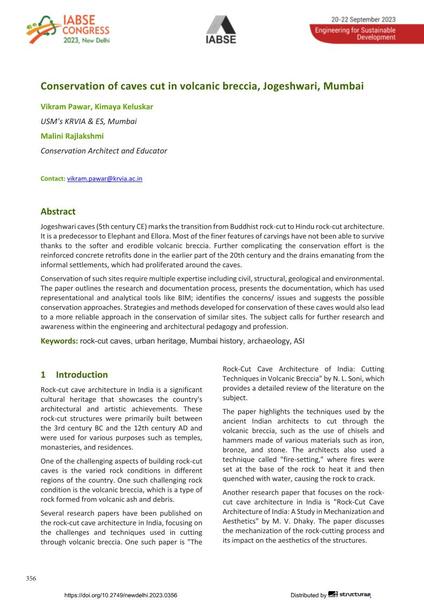Conservation of caves cut in volcanic breccia, Jogeshwari, Mumbai

|
|
|||||||||||
Bibliografische Angaben
| Autor(en): |
Vikram Pawar
(USM’s KRVIA & ES, Mumbai)
Kimaya Keluskar (USM’s KRVIA & ES, Mumbai) Malini Rajlakshmi (Conservation Architect and Educator) |
||||
|---|---|---|---|---|---|
| Medium: | Tagungsbeitrag | ||||
| Sprache(n): | Englisch | ||||
| Tagung: | IABSE Congress: Engineering for Sustainable Development, New Delhi, India, 20-22 September 2023 | ||||
| Veröffentlicht in: | IABSE Congress New Delhi 2023 | ||||
|
|||||
| Seite(n): | 356-362 | ||||
| Anzahl der Seiten (im PDF): | 7 | ||||
| DOI: | 10.2749/newdelhi.2023.0356 | ||||
| Abstrakt: |
Jogeshwari caves (5th century CE) marks the transition from Buddhist rock-cut to Hindu rock-cut architecture. It is a predecessor to Elephant and Ellora. Most of the finer features of carvings have not been able to survive thanks to the softer and erodible volcanic breccia. Further complicating the conservation effort is the reinforced concrete retrofits done in the earlier part of the 20th century and the drains emanating from the informal settlements, which had proliferated around the caves. Conservation of such sites require multiple expertise including civil, structural, geological and environmental. The paper outlines the research and documentation process, presents the documentation, which has used representational and analytical tools like BIM; identifies the concerns/ issues and suggests the possible conservation approaches. Strategies and methods developed for conservation of these caves would also lead to a more reliable approach in the conservation of similar sites. The subject calls for further research and awareness within the engineering and architectural pedagogy and profession. |
||||
